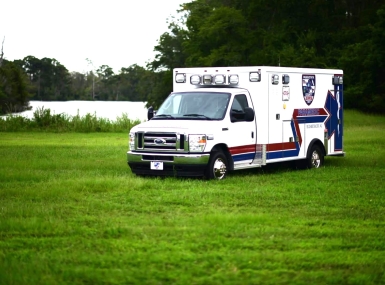Changes to public safety spectrum comes at major cost for counties
Author
Upcoming Events
Related News

Since 2012, the countdown has been on for a major shift in county public safety communications that has a hefty price tag attached.
A provision in The Middle-Class Tax Relief and Job Creation Act of 2012 (Public Law 112-96) requires the Federal Communications Commission (FCC) to reallocate a spectrum associated with broadcast channels in the 470 to 512 megahertz band, commonly referred to as the T-Band. Counties rely on the T-Band for a variety of public safety purposes including emergency medical service, 911 communications, fire departments and law enforcement agencies.
The legislation calls for an auction to be held by Feb. 22, 2021 and would require all public safety operations on the band to close within two years.
According to the FCC, there are 925 public safety entities with licenses in the T-Band including 11 metropolitan areas: Boston, Chicago, Dallas/Fort Worth, Houston, Los Angeles, Miami, New York City, Philadelphia, Pittsburgh, San Francisco/Oakland and Washington D.C.
The T-Band spectrum dates back to the early 1970s when the FCC allocated the 470 to 512 megahertz band to public safety in urban areas with large populations to alleviate shortages of radio channels.
In Nassau County, N.Y., which is located east of New York City on Long Island, the T-Band is the public safety network for law enforcement and covers all areas of the county.
Nassau County Police Chief Ron Walsh said the cost to move off the spectrum and rebuild a communications system is the main challenge for the county when it comes to the T-Band auction.
“We’re at about $120 million dollars that we’re going to have to put into the system over the next couple of years to build it, but it’s also happening in a year when COVID hit and all revenues across the county are dramatically impacted,” he said.
Walsh said the cost to rebuild systems can vary depending on the geographical challenges of an area. Specifically, in Nassau County, Walsh said being surrounded by water and dealing with hills creates added complications.
Nassau County has already started working with Motorola to scope out an entire rebuild of the system to shift the county to the 700 to 800 megahertz band, which is available for public safety channels.
“You can’t just rebuild these things overnight,” he said. “It’s a tremendous amount of work that goes into it and we don’t own all the sites that we transmit and receive from, so we have to coordinate with site owners.”
Walsh said the county is planning its transition in phases. There are already a few 700 to 800 megahertz sites available to serve as placeholders for licenses. Starting next year, the entire infrastructure will be replaced.
While proceeds from the auction are to be made available to jurisdictions with incurred costs from moving off the T-Band spectrum, Walsh said he is concerned over the distribution of these funds.
“The only problem is that the estimates that we’re getting from the agencies that track these things is that they’re talking, if they’re lucky, they’ll get a few $10 billion worth of proceeds,” he said of the money that would be divided among jurisdictions that make the move off the T-Band.
The transition to the 700 to 800 megahertz band is not as simple as flipping a switch.
Walsh said the T-Band can’t be shut off without having a 700 to 800 band to turn on. Both systems will initially need to run simultaneously, which requires purchasing dual band radios, new portables and new mobile radios for police vehicles. This comes with added costs and increased time needed to train users.
“You’re talking about lives now and the lives of public safety officers and you want to be able to do that safely and all these things and equipment is a lot of money and a lot of time,” he said.
Walsh said this mandate from the federal government is going to put counties further and further in debt.
“I just hope that the federal government recognizes the complicated nature of building these systems and being able to roll them out safely and they give us the time that we need to do it,” Walsh said.
“Their entitled to mandate these things, but the funding to assist with this is really what we need and for them to give us a little more time and start to allocate some money to offset some of the costs would be very much appreciated by the county governments,” he added.
Across the river on the other side of New York City, Bergen County, N.J. is another jurisdiction that relies wholly on the T-Band spectrum.
“Our entire countywide trunked radio system operates off the T-Band at this point,” Frank Del Vecchio, director of Communications and Public Safety Operations, said.
It would cost the county between $15 million and $20 million to move off the T-Band and replace subscriber equipment which includes portable radios, mobile radios and other infrastructure, according to Del Vecchio.
“This is going to have such a great impact on public safety communications throughout the nation and billions upon billions of dollars,” he said.
Similar to Nassau County, Bergen County started taking steps to install three 700 megahertz sites around the county with plans to build more. Del Vecchio said this puts the county in a better position to be prepared for the T-Band auction.
He added that he wishes the federal government would recognize the investment that cities and counties have already made in their radio communications infrastructure.
“Leaving T-Band would have an impact on our services and our ability to provide public safety communications for our emergency responders,” he said.
In September, the House passed the Don’t Break Up the T-Band Act of 2020 to prevent the T-Band spectrum auction. The bill is now in the Senate for consideration.
“Police officers, firefighters, emergency medical technicians and paramedics are relying on this T-Band network in so many cities and areas across the country that it would just have a very negative impact on public safety,” Del Vecchio said.

Attachments
Related News

Senate passes Second Chance Act reauthorization
On May 22, the Second Chance Reauthorization Act of 2025 (H.R. 3552/S.1843) was introduced in the U.S. Senate and the U.S. House of Representatives with robust bipartisan support. NACo supports this legislation, which would reauthorize funding for Second Chance Act (P.L. 110-199) programs through 2030.

FEMA delays $11 billion in state disaster reimbursements
The Federal Emergency Management Agency (FEMA) recently withheld roughly $11 billion in planned disaster reimbursements to 45 states, shifting the payments to fiscal year 2026 and marking a major change in how the federal government is managing disaster relief funding.

Nuanced EMS response addresses paramedic shortage
Facing a shortage of paramedics, Pasquotank County, N.C. created a response program that better assigns its personnel to where their skills are most needed.
